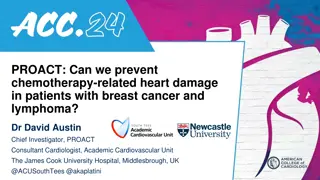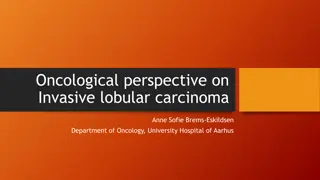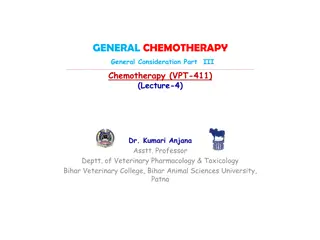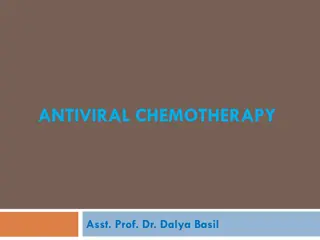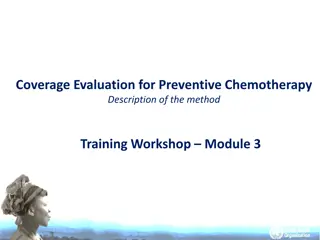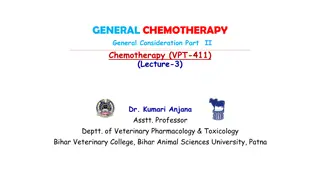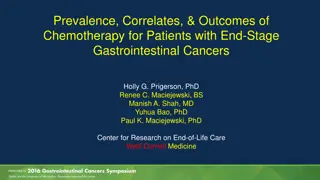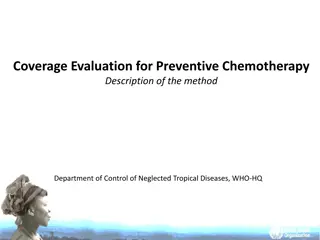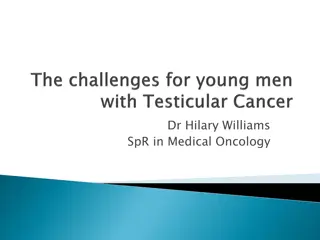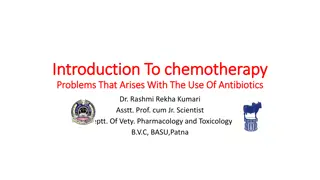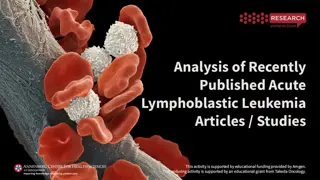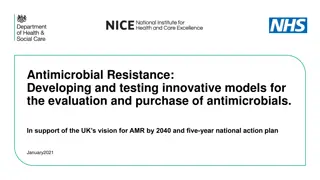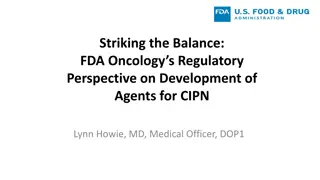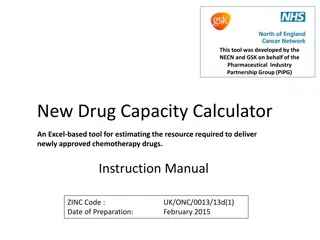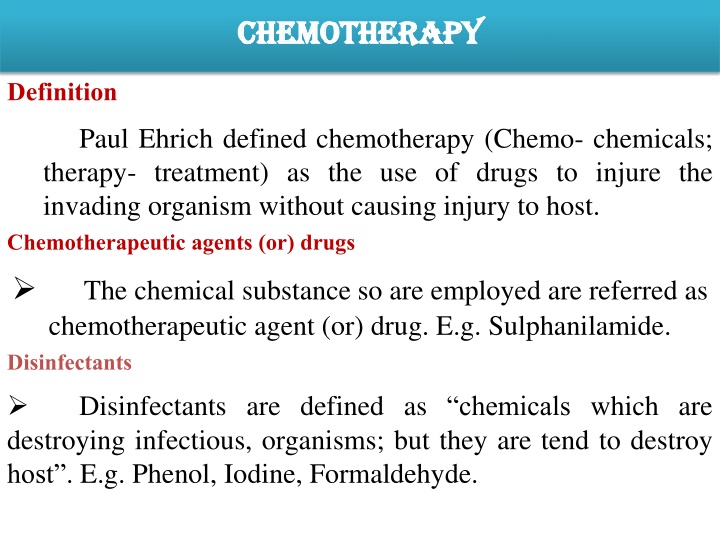
Chemotherapy and Antimicrobials
Chemotherapy, as defined by Paul Ehrlich, involves the use of drugs to target invading organisms while sparing the host. This includes chemotherapeutic agents like sulphanilamide. Antimicrobials, such as disinfectants and sulpha drugs, play a vital role in combating infections like pneumonia, syphilis, malaria, and more. Additionally, antimalarials like chloroquine and arsenical drugs like Salvarsan-606 are essential in treating specific diseases caused by pathogens.
Download Presentation

Please find below an Image/Link to download the presentation.
The content on the website is provided AS IS for your information and personal use only. It may not be sold, licensed, or shared on other websites without obtaining consent from the author. If you encounter any issues during the download, it is possible that the publisher has removed the file from their server.
You are allowed to download the files provided on this website for personal or commercial use, subject to the condition that they are used lawfully. All files are the property of their respective owners.
The content on the website is provided AS IS for your information and personal use only. It may not be sold, licensed, or shared on other websites without obtaining consent from the author.
E N D
Presentation Transcript
Chemotherapy Chemotherapy Definition Paul Ehrich defined chemotherapy (Chemo- chemicals; therapy- treatment) as the use of drugs to injure the invading organism without causing injury to host. Chemotherapeutic agents (or) drugs The chemical substance so are employed are referred as chemotherapeutic agent (or) drug. E.g. Sulphanilamide. Disinfectants Disinfectants are defined as chemicals which are destroying infectious, organisms; but they are tend to destroy host . E.g. Phenol, Iodine, Formaldehyde.
SULPHA DRUGS (OR) ANTIBACTERIALS a synthetic chemotherapeutic agent, contains It s sulphonamide group (-SO2NH2). Sulpha drugs are used to cure bacterial infections. So it s called as antibacterial & they are bacteriostatic Bactericide. Preparation ofsuphanilamide not
Sulphadiazine Applications of sulpha drugs such as Sulpha drugs has been used in the treatment of various diseases infections, throat infections and syphilis. Pneumonia, influenza, typhoid, malaria, dysentery, ulcer, urinary
ANTIMALARIALS ANTIMALARIALS Drugs used against malarial parasites are called antimalarials. Malaria is caused by the protozoa Plasmodium. Most effective antimalarial drug is qunine which is obtained from the extract of Chincona bark . Some synthetic antimalarial drugs are 1. 4-amino quinolines (E.g. Chloroquine) 2. 8-amino quinolines (E.g. Plasmoquine) 3. 9-amino quinolines (E.g. Quinacrine) and 4. Sulphones.
Chloroquine (Aralen) . amino-1-diethylaminopentane. It is synthesized by condensation of 4,7-dichloroquinoline and 4- The phosphate salt is obtained by the treatment of chloroquine with phosphoric acid.
Plasmoquine It is synthesized by the condensation of 8-amino-6-methoxy quinoline with 4-bromo-1-diethylaminopentane.
Arsenical Arsenical drugs (or) drugs (or) Anti Anti protozoals protozoals protozoa diseases called arsenical drugs. Salvarsan-606 (3.3 -diamino,4,4 -dihydroxyarseno benzene) The production of salvarsan-606 was the greatest achievement in chemotherapy. Organometallic compounds of arsenic are used to cure certain each) linked through arsenic atoms(no carbon atom). The salvarsan molecule has two benzene ring(6-carbon atoms
Salvarsan-606 is a pale yellow hygroscopic powder and its readily oxidized by air so sodium salt solution of salvarsan-606 is used. Neosalvarsan (3,3 -diamino 4,4 -dihydroxy arsenobenzene N-methanal sulphoxylate) The sodium salvarsan solution is very unstable and The sodium salvarsan solution is very unstable and must be prepared before use. This problem is removed by, Neosalvarsan is a derivative of salvarsan-606. Uses syphilis and venereal diseases. Salvarsan-606 and Neosalvarsan are used for the treatment of
Antibiotics (or) Antimicrobials These are chemical substances produced by (or) derived from living organism like fungi and molds, which are capable of inhibiting the growth (or) even destroy micro-organism. Classification of antibiotics Based on their Mode of application Based on mode of applications antibiotics are classified in to two types. They are as follows, i) Broad spectrum antibiotics and ii) Narrow spectrum antibiotics
Broad spectrum antibiotics The one antibiotic which may be used against a large number of microorganisms and are capable to curing many diseases called broad spectrum antibiotics. Antibiotic Disease controlled Penicillin Pneumonia, rheumatic fever, syphilis. Streptomycin Tuberculosis, plague, influenza Tetracyclines Pneumonia, Typhoid fever, Tuberculosis, Bronchitis and vanereal diseases. Narrow spectrum antibiotics The antibiotics are specific in their action and hence active against some specific diseases. E.g. Bacitracin, Nystatin..
Based on the type of bacteria destroyed Antibiotic is classified in to two types based on which type of bacteria destroyed by itself. i) Gram positive antibiotics ii) Gram negative antibiotics Gram positive antibiotics These are active against Gram positive bacteria. E.g. Penicillins, Tetracylines. Gram negative antibiotics These are active against Gram negative bacteria. E.g. Chloromphenicol.
Based on their chemical structure follows Based on the structure of antibiotics classified as i) Amino acid congeners (e.g. Chloromphenicol) ii) - lactams (e.g. Penicillins) iii) Fused ring systems (Tetracyclines).
Penicillin Penicillin which inhibit the growth of certain bacteria. The name penicillin is used for a mixture of natural compounds having molecular formula C9H11N2O4SR. Penicillin molecules having -lactum ring (A) fused to thioazolidine moiety (B). Six natural penicillins have been isolated. Fleming in 1928 discovered a mould of the penicillin species,
Name Chemical name R-group Penicillin-I (or) F Pent-2-enyl penicillin Penicillin-II (or) G Benzyl penicillin Penicillin-III (or) X p-hydroxy benzyl penicillin -(CH2)6-CH3 Penicillin-IV (or) K n-heptyl penicillin Penicillin-V Phenoxy methyl penicillin Dihydro-F-penicillin n-amyl penicillin -(CH2)4-CH3
Penicillin-I (or) Penicillin- F (or) Pent-2-enyl penicillin Penicillin-II (or) Penicillin- G (or) Benzylpenicillin
Penicillin-III (or) X (or)p-hydroxy benzyl penicillin Penicillin-IV (or) K (or)n-heptyl penicillin
Penicillin-V (or) Phenoxy methyl penicillin Dihydro-F-penicillin (or) n-amyl penicillin
Penicillins are active against Gram positive bacteria and they shows poor activity against Gram negative bacteria. Penicillins are the safest drug to the mankind and are broad spectrum antibiotics. Penicillins have been administrated only by injection. Limitation of penicillins In some persons administration of penicillin causes allergic reaction. Penicillins are sensitive to enzymes (e.g. - lactamases). This enzyme catalyzes the degradation of penicllins.
Amoxicillin and Amoxicillin and ampicillin Penicillins are non active against Gram negative bacteria. To overcome this problem has been done by attaching hydrophilic groups such as NH2, -COOH, -OH group to the carbon atom alpha atom to the carbonyl group on the side chains. ampicillin Gram negative bacteria than penicillin but less active against Gram positive bacteria. They are not degraded by penicillase. Amoxycillin and ampicillin are active against a wide range of
Tetracyclines Tetracyclines wide range of human and animal pathogens. Tetracyclines are powerful broad spectrum antibiotics against a These are active against both Gram positive and negative bacteria, viruses, protozoa and parasites.
Name R & R1 group Tetracyline R = R1 = H Aureomycin R= Cl, R1= H Tetramycin R= H, R1= OH Uses the skin, intestines, respiratory tract, urinary tract, genitals, lymph nodes, and other body systems. It is often used in treating severe acne, or sexually transmitted diseases such as syphilis, gonorrhea, or chlamydia Tetracycline is used to treat many different bacterial infections of
Streptomycin Streptomycin Streptomycin was isolated by Waksman etal (1994) from cultures of streptomyces. meningitis and pneumonia. Streptomycin is very active in the treatment of negative bacteria and microbial infections. Streptomycin is widely used to treat Gram-
Hormones Hormones Hormones are chemical messengers. Hormones are secreted by the endocrine (ductless) glands such as pituitary, thyroid, pancreas etc at different sites in the body. activity in the body. They occur in trace amounts ad exhibit specific physiological
Testosterone Testosterone Testosterone is the primary male sex hormone and an anabolic steroid. In male humans, testosterone plays a key role in the development of male reproductive promoting secondary sexual increased muscle and bone mass, and the growth of body hair. It is secreted by testis from cholesterol. Testosterone plays an important role in regulating insulin, glucose, and fat metabolism. tissues characteristics as well as as such
Progesterone Progesterone hormone cycle, pregnancy, embryogenesis and plays an important role in brain function as a neurosteroid. progesterone is synthesized from pregnenolone, which itself is derived from cholesterol. Progesterone is the primary female sex involved in the menstrual
Thyroxin Thyroxin 3,5,3 ,5 -tetraiodothyronine Thyroxin is secreted by the thyroid gland. Thyroxin s principal function the consumption of oxygen and thus the metabolism of all cells and tissues in the body. is to stimulate

